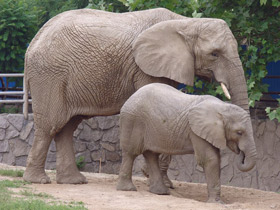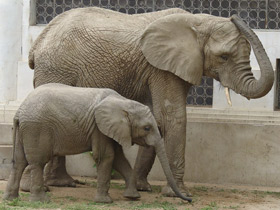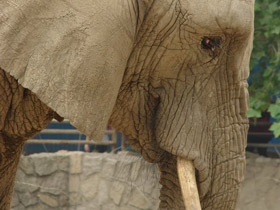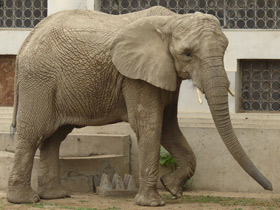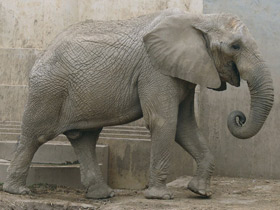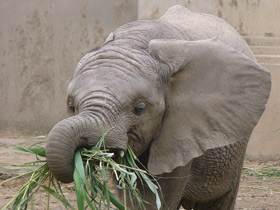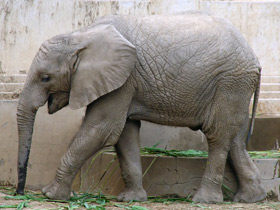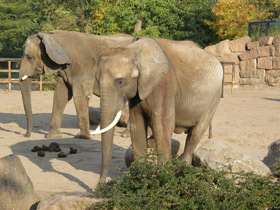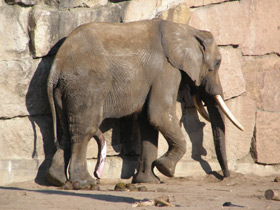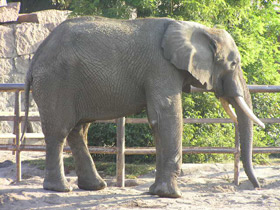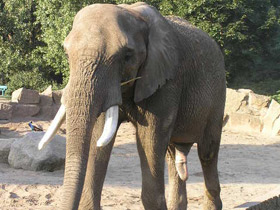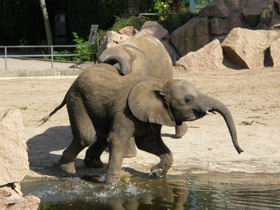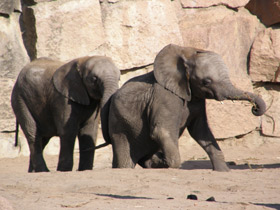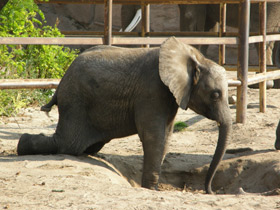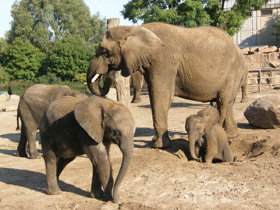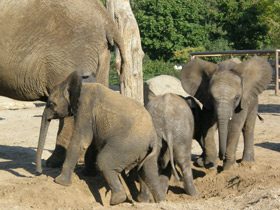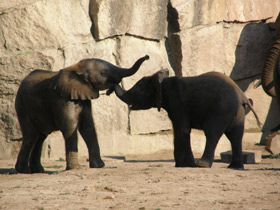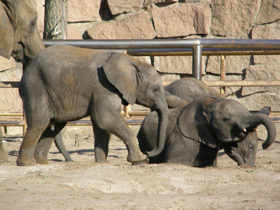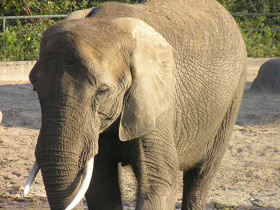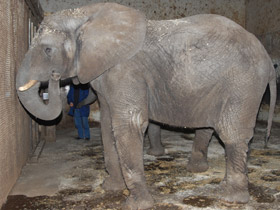African elephant Loxodonta africana
The African elephant is the largest land animal on Earth. Older individuals of the African elephant may weigh up to 7.5 tons and reach a shoulder height of 4 meters. Average weight of the male is 5 tons, that of the female, 3 tons. Most dangerous weapon of the elephants is their tusks that measure 3 to 3.5 meters in length and weigh about 100 kg. These animals are perfectly adapted to African hot climate: their huge ears serve an ideal mechanism of cooling. Elephants also fan themselves with their ears to cool down.
African elephants live in herds consisting of 9 to 12 closely related animals. They migrate annually, with the oldest and wisest female being responsible for the selection of migratory route. Observations demonstrate that behavioural patterns of the elephants living in the forests differ from what is seen in the elephants ranging in the plains. Earlier dispersal of young elephants is typical for forest elephants. In savannahs, baby elephants may be killed by lions and therefore early dispersal is dangerous for young animals. This danger is not present in the forests and forest elephants become independent at earlier age.
Despite their bulky stature, elephants are surprisingly agile, nimble, and fast-moving. Elephants can swim excellently, with only the tip of their trunk showing over the water surface; they effortlessly climb steep riverbanks and feel comfortable in rocky landscapes. A sight of forest elephants is striking. These elephants soundlessly make their way through extremely dense vegetation. They seem to be ghosts; there are no sounds of disturbed branches or grass. Moving at an even stride, African elephants are able to travel long distances while escaping from their enemies or searching for food; sometimes they cover distances of dozens of kilometres during the night time. African elephants range throughout large areas in sub-Saharan Africa and rain forests of Central and West Africa. African elephants were historically found also in North Africa but they completely disappeared in that region. African elephants have wide but patchy distribution; they can be seen in large numbers in national parks and nature reserves. Thus, in the 1920-s elephants inhabited 70% of the territory of Uganda and now their habitats are restricted to just 17% of the territory of the country. Many African countries do not have protected areas for elephants. Elephants usually live in groups but there are now almost no herds consisting of hundreds of animals, which were described by travellers in the past century. Elephant family typically consists of 9-12 adult, juvenile and very young animals. The family is usually headed by an oldest and largest female known as the matriarch though sometimes, especially during migrations, it may be a male to lead the herd. Individual elephants in the herd are closely bounded for life. They know each other and tend to protect the calves together; elephants are known to aid injured members of the family, helping them to go away from dangerous place. Fights are not common among elephants. Humans are their main enemies. Elephants produce rumbling, screaming, crying, rasping, and barking sounds. Elephants do not mate and breed in specific time. Before mating, the male and the female usually separate themselves from the herd; mating is preceded by complex courtship behaviour. The gestation period is 22 months. The newborn elephant normally weighs about 100 kg and has a height of one meter; its trunk is quiet short and the little elephant does not have tusks. Baby elephants can not live independently and need to be cared for by their mothers. Young elephants reach sexual maturity by the age of 12 to 20 years. Lifespan of the elephants is 60 to 70 years. Females typically breed once in four years.
The history of African elephants is marked by most interesting and dramatic events. The African elephant is the largest mammal but it is also one of the most unfortunate ones. For centuries, the elephant's tusks (so called elephant ivory) have been valued like gold. The scale of elephant hunt was not large before the arrival of armed Europeans in the late 19th century. Numerous hunters killed elephants, using double set-trigger rifles, then wrenched out the tusks, and left huge carcasses for vultures and hyenas. Hundreds and thousands of elephant carcasses were rotting in the forests and savannahs of Africa; meanwhile, poachers’ profits reached incredible highs. The tusks of old bulls had a length of 3-3.5 meters and weighed 100 kg each (the largest pair of the tusks weighed 225 kg, with the length of 4.1 meters). During the 1880's and 1890's the ivory trade in East Africa drove elephant numbers down, with 60,000 to 70,000 elephants being killed annually. But already in 1913, just 10,000 pairs of tusks were exported from Africa, in 1920 through 1928, export dropped to 6,000 pairs of tusks per year. Elephants were becoming increasingly rare.
Worldwide concern over the decline of the elephant led to a complete ban on the ivory trade in 1990. Elephants have been included in Appendix I of the Convention on International Trade in Endangered Species (CITS). A network of national parks contributed in the conservation of African elephants. Conservation measures have brought promising results: currently, the population numbers are estimated at over 400,000 individuals (which is probably more than 100 years ago). However, the growth of the population resulted in the increase of elephant densities within restricted habitats. This phenomenon presents a new threat for the elephants and raises new concerns about African elephants. The problem is that one elephant consumes up to 100 kg of grass, browse, and branches every day. Estimates show that one elephant needs to consume a mass of vegetation growing over the area of about 5 sq. km. for its survival during one year. Besides, foraging elephants often cut down trees and strip off bark from tree trunks. In the past, elephants migrated over the distances of hundreds kilometres and there was enough time for destroyed vegetation to restore. In our times, elephants live in restricted habitats which do not have enough food resources to support the animals. In some paces elephants are given supplementation to their diets (such as oranges!). Many national parks are fenced with electrical wire so that the elephants could not destroy neighbouring plantations. With limited feeding range, the elephants resorted to destruction and utilization of various parts of the forest trees in national parks (for instance, Murchison Falls National Park) threatening their further existence. Degraded forest vegetation is replaced with dense spiny thickets or bunchgrass steppes which do not provide suitable habitats for forest animals, including elephants. This process dictates the need to control elephant populations and some national parks adopted elephant culling practice. In the beginning of the 20th century, the program of domestication of elephants was initiated in the Belgian Congo. Training elephants for transport and labour was carried out for several dozen years and the program was partially successful but did not have any practical implications though it is well known that Hannibal used African elephants in his campaign against Rome (and in those times, elephants ranged in the north of Africa and were domesticated there).

















